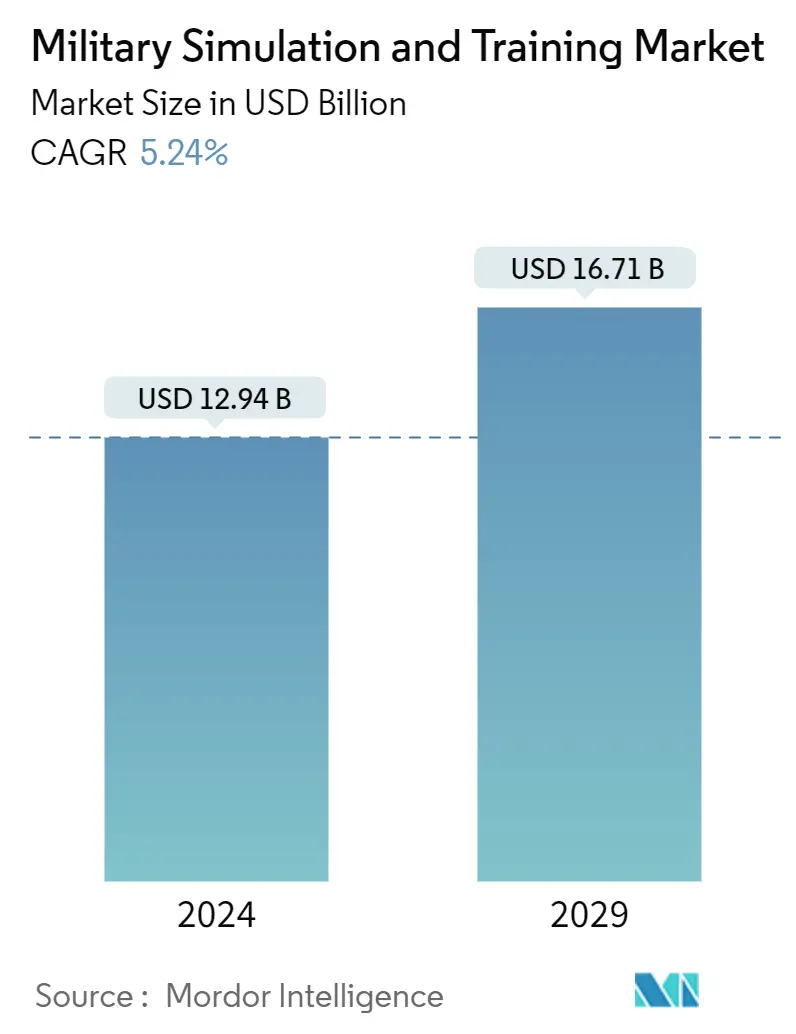Market Size of Military Simulation And Training Industry

| Study Period | 2019 - 2029 |
| Market Size (2024) | USD 12.94 Billion |
| Market Size (2029) | USD 16.71 Billion |
| CAGR (2024 - 2029) | 5.24 % |
| Fastest Growing Market | North America |
| Largest Market | North America |
Major Players.webp)
*Disclaimer: Major Players sorted in no particular order |
Military Simulation And Training Market Analysis
The Military Simulation And Training Market size is estimated at USD 12.94 billion in 2024, and is expected to reach USD 16.71 billion by 2029, growing at a CAGR of 5.24% during the forecast period (2024-2029).
The continued growth in global defense spending combined with the increased need for skilled forces to successfully navigate and operate various new combat vehicles is expected to propel the growth of the military simulators and training market during the forecast period.
The growth in demand for military vehicles across the land, sea, and aerial platforms is the primary driver of the market growth. Several countries are modernizing their military fleet by inducting newer generation vehicle platforms, generating a simultaneous demand for simulation-based training for the military personnel on these platforms, thereby propelling the market prospects of the affiliate military simulators.
The training of pilots and military personnel in real aircraft, land vehicles, and ships involves multiple risks and sometimes may lead to hazardous situations and fatalities. Simulators provide a realistic experience and safety training for beginners. This need for safe and efficient training is also driving the simulator market.
Product development in the simulators market is lengthy, as it takes a significant amount of time to develop a replica of any aircraft tested. They also need to comply with safety and regulatory management issues, making it a challenge to deliver the required simulators on time.
Military Simulation And Training Industry Segmentation
Military simulation training extensively uses modern simulation technology based on computers, virtual reality, artificial intelligence, and distributed simulation to replicate weapon system performance, combat environment, and combat itself. The department and trainees can feel the environment like an actual installation and like an actual conflict by using high-fidelity simulations of their adversary, combat mission, and combat procedure. This can maximize their training level.
The military simulators and training market is segmented by platform and geography . By platform, the market is segmented into aerial, naval, and terrestrial. The report also covers the market sizes and forecasts for the military simulators and training market in major countries across different regions.
For each segment, the market size is provided in terms of value (USD).
| By Platform | |||||
| |||||
| |||||
|
| Geography | ||||||||
| ||||||||
| ||||||||
| ||||||||
| ||||||||
|
Military Simulation And Training Market Size Summary
The military simulators and training market is poised for significant growth, driven by the increasing global defense expenditure and the need for advanced training solutions to operate modern combat vehicles. As countries modernize their military fleets with new-generation platforms across land, sea, and air, the demand for simulation-based training is rising. Simulators offer a safe and cost-effective alternative to real-world training, reducing risks and expenses associated with training on actual vehicles. This trend is further supported by the adoption of complex technologies in military aircraft, where simulators provide essential hands-on experience without the high costs of real aircraft operations. The market is characterized by product development challenges due to the lengthy process of creating realistic simulators that comply with safety and regulatory standards.
The market landscape is semi-consolidated, with key players like Collins Aerospace, CAE Inc., Rheinmetall AG, FlightSafety International Inc., and THALES leading the charge. These companies are expanding their market presence through strategic mergers and acquisitions, such as CAE Inc.'s acquisition of L3Harris Technologies' Military Training business. Such moves are expected to enhance their revenue share and addressable market. The demand for simulators is further fueled by initiatives like the US Air Force's plans to connect full-mission simulators internationally and collaborations in electronic warfare simulation in Europe. As defense departments worldwide increasingly invest in simulator solutions, the market is set to experience robust growth, with intense competition among manufacturers offering innovative and cost-effective training solutions.
Military Simulation And Training Market Size - Table of Contents
-
1. MARKET DYNAMICS
-
1.1 Market Overview
-
1.2 Market Drivers
-
1.3 Market Restraints
-
1.4 Porter's Five Forces Analysis
-
1.4.1 Bargaining Power of Suppliers
-
1.4.2 Bargaining Power of Buyers/Consumers
-
1.4.3 Threat of New Entrants
-
1.4.4 Threat of Substitute Products
-
1.4.5 Intensity of Competitive Rivalry
-
-
-
2. MARKET SEGMENTATION
-
2.1 By Platform
-
2.1.1 Terrestrial
-
2.1.1.1 Armored Tanks
-
2.1.1.2 Howitzers
-
2.1.1.3 Other Platforms
-
-
2.1.2 Naval
-
2.1.2.1 Naval Vessels
-
2.1.2.2 Submarines
-
2.1.2.3 Other Naval Vessels
-
-
2.1.3 Aerial
-
2.1.3.1 Fixed-wing Aircraft
-
2.1.3.2 Rotary-wing Aircraft
-
-
-
2.2 Geography
-
2.2.1 North America
-
2.2.1.1 United States
-
2.2.1.2 Canada
-
-
2.2.2 Europe
-
2.2.2.1 Germany
-
2.2.2.2 United Kingdom
-
2.2.2.3 France
-
2.2.2.4 Russia
-
2.2.2.5 Spain
-
2.2.2.6 Rest of Europe
-
-
2.2.3 Asia-Pacific
-
2.2.3.1 India
-
2.2.3.2 China
-
2.2.3.3 Japan
-
2.2.3.4 South Korea
-
2.2.3.5 Rest of Asia-Pacific
-
-
2.2.4 Latin America
-
2.2.4.1 Brazil
-
2.2.4.2 Argentina
-
-
2.2.5 Middle East & Africa
-
2.2.5.1 United Arab Emirates
-
2.2.5.2 Saudi Arabia
-
2.2.5.3 South Africa
-
2.2.5.4 Rest of Middle East & Africa
-
-
-
Military Simulation And Training Market Size FAQs
How big is the Military Simulation And Training Market?
The Military Simulation And Training Market size is expected to reach USD 12.94 billion in 2024 and grow at a CAGR of 5.24% to reach USD 16.71 billion by 2029.
What is the current Military Simulation And Training Market size?
In 2024, the Military Simulation And Training Market size is expected to reach USD 12.94 billion.

